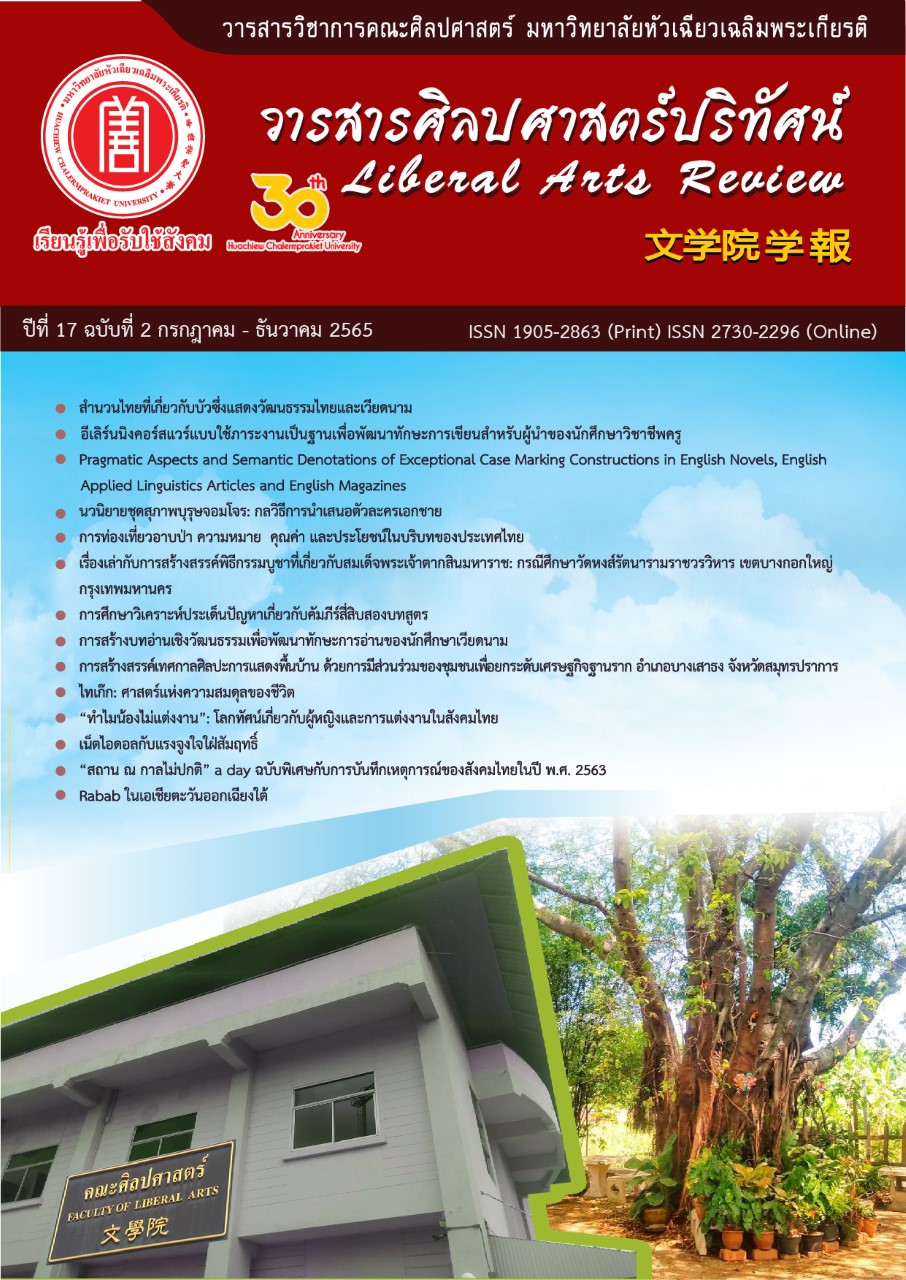Creation of folk performing arts festival by community participation to improve the local economy of Bang Saotong District, Samutprakarn
DOI:
https://doi.org/10.14456/lar.2022.19Keywords:
Folk Performing Arts Festival, Live Steaming, On GroundAbstract
This research study about the creation of a performing arts and folk festival with community participation that aimed to improve the local economy of Bang Saotong District, Samutprakarn. The objectives were 1. to study the problems of local performing arts entrepreneurs in Sisa Chorakhe Yai 2. to study the guidelines and creativity in organizing the Sisa Chorakhe Yai Folk Performing Arts Festival 3. to assess the Return on Investment and Social Return on Investment (ROI/SROI). A qualitative research methodology was used. The research took the form of participatory action research that consisted of: document gathering, related research reports, participant and non-participant observation, in-depth interviews, group chats, organizing a community forum, knowledge management and feedback to the community. The study found that the main problem was the severity of the COVID-19 epidemic which affected the folk performing arts entrepreneurs in Sisa Chorakhe Yai. The secondary problem was the lack of marketing communication. Moreover, people are now focusing on new media online which led to the decline in folk performances popularity. There were 11 guidelines for organizing the Folk Performing Arts Festival 1.emphasize identity from the root to make it stand out 2. categorize activities and areas 3.arrange learning activities, exhibitions and discussions 4. build a platform to help artists 5. create a visual focus within the event 6. create an engaging storyline from start to finish 7. create story telling from actors' lives 8. invite expert artists to talk 9. organize live online events 10. invite vendors 11. the community is the owner of the Folk Performing Arts Festival and various agencies act as supporters in 5 steps. The Folk Performing Arts Festival included both online broadcasting (Live Steaming) and on ground (onsite?) activities according to security measures necessitated by the COVID-19 situation. The assessment of economic return on investment (ROI) after the Folk Performing Arts Festival, Khon Sod Khru Wik Chimphli School ROI = 31 % with an average total income per year of 720,000 baht, Ban Sri Ket Thai Music Group ROI = 82 % with an average total income per year of 1,440,000 baht, Klong Yow Bunyadsil ROI = 33 % with an average total income per year of 288,000 baht, Tham Kwan Nak Kwan Ruen Luk Prakan group ROI = 100 % with an average total income per year of 672,000 baht. The Social Return on Investment (SROI) of 410,744.71 baht could generate value from the investment in the amount of 3,741,866.35 baht. When calculating the social impact assessment compared to the investment in the amount of 1 baht, the social return is SROI = 9.11 baht. Concluded that the project was worth investing in.
References
กรณิศ รัตนามหัทธนะ. (2561). วันงานเทศกาลผ่านมา. ค้นคืนจาก https://bit.ly/3bYkfeh.
กฤตฤณ ช้างทองคำ. (30 มกราคม 2564). สัมภาษณ์.
กาญจนา แก้วเทพ และคณะ. (2553). การบริหารจัดการวัฒนธรรมพื้นบ้านแบบมีส่วนร่วมด้วยนวัตกรรมการวิจัย. กรุงเทพมหานคร: ห้างหุ้นส่วนจำกัดภาพพิมพ์.
เกรียงไกร กาญจนะโภคิน. (2555). Event marketing. กรุงเทพมหานคร: กรุงเทพธุรกิจ.
ขนิษฐ ศรีเกตุ. (16 มกราคม 2564). สัมภาษณ์.
ขวัญเรือน เกตุขวง. (16 มกราคม 2564). สัมภาษณ์.
คณปกรณ์ จันทร์สมบูรณ์. (2565). เพลงและการแสดงพื้นบ้านภาคกลาง: บทบาทและการนำเสนอที่เกี่ยวข้องกับมหันตภัยโควิด-19. วารสารข่วงผญา มหาวิทยาลัยราชภัฏเชียงใหม่, 15(2), 56–86.
จิตราภรณ์ จรัสรัมย์. (2561). ขั้นตอนการจัดงานอีเวนท์ กรณีศึกษางาน ICONSIAM Grand Opening จัดโดย บริษัท อินเด็กซ์ครีเอทีฟ วิลเลจ จำกัด (มหาชน). (ปริญญานิพนธ์ปริญญามหาบัณฑิต). บัณฑิตวิทยาลัย มหาวิทยาลัยกรุงเทพ, กรุงเทพมหานคร.
เธียรชัย อิศรเดช. (2548). ศักยภาพโนราในการพัฒนาท้องถิ่น. กรุงเทพมหานคร: สำนักงานกองทุนสนับสนุนการวิจัย.
ประหยัด กลิ่นพวง. (16 มกราคม 2564). สัมภาษณ์.
พีรพงศ์ เสนไสย. (2562). นาฏยพาณิชย์. มหาสารคาม: รัตนชัย ก็อปปี้ เซ็นเตอร์ อาคารบริการกลาง (พลาซ่า) มหาวิทยาลัยมหาสารคาม.
รัฐบาลไทย. (2565). วธ.อนุรักษ์สืบสานการแสดงศิลปวัฒนธรรมพื้นบ้าน. ค้นคืนจาก https://www.thaigov.go.th/news/contents/details/53161.
วิก ฉิมพลี. (16 มกราคม 2564). สัมภาษณ์.
วิศิษฎ์ เกตุรัตนกุล, ณัฐฐ์วัฒน์ สุทธิโยธิน และสุภาภรณ์ ศรีดี. (2562). กลยุทธ์การแพร่ภาพสดผ่านเฟซบุ๊กไลฟ์ขาย สินค้าแฟชั่นกับพฤติกรรมการตัดสินใจซื้อของผู้บริโภค. วารสารนิเทศสยามปริทัศน์ มหาวิทยาลัยสยาม, 18(24), 117-129.
ไวฑูรย์ โภคาชัยพัฒน์. (2561). ผลตอบแทนทางสังคม เรื่องน่าสนใจสู่องค์กรยั่งยืน. ค้นคืนจาก https://forbesthailand.com/commentaries/insights/ผลตอบแทนทางสังคม-เรื่อง.
ศูนย์สื่อสารนานาชาติแห่งจุฬาฯ. (2554). แบบจำลองการสื่อสารงอขงลาสแวลล์. ค้นคืนจาก http://www.chulapedia.chula.ac.th/index.php?title=แบบจำลองการสื่อสารของลาสแวลล์.
อัษฎาวุฒิ ศรีทน และอุมารินทร์ ตุลารักษ์ (2564). ทุนทางวัฒนธรรมในมิติการท่องเที่ยวชุมชนที่อธิบายผ่านเรื่องเล่าตำนาน ประวัติศาสตร์ท้องถิ่น ในวิถีชีวิตชุมชน. วารสารศิลปศาสตร์ปริทัศน์ มหาวิทยาลัยหัวเฉียวเฉลิมพระเกียรติ 16 (2), 141-158.
Lasswell, H.D. (1948). The Structure and function of communication in society. In L. Bryson(Ed.), The communication of ideas (pp.216). New York: Harper and Brothers.
The Momentum Team. (2563). ศิลปินผุดไอเดียทำ Social Distancing Festival ทางออนไลน์หลังจากงานแสดงต่าง ๆ ถูกยกเลิกเพราะโควิด-19. ค้นคืนจาก https://themomentum.co/social-distancing-festival/
Schramm, w. (1974). Nature of Communication between humans in W. Urbana IL: University of Illinois.
Downloads
Published
How to Cite
Issue
Section
License
Copyright (c) 2022 Liberal Arts Review

This work is licensed under a Creative Commons Attribution-NonCommercial-NoDerivatives 4.0 International License.
บทความที่ได้รับการตีพิมพ์เป็นลิขสิทธิ์ของวารสารศิลปศาสตร์วิชาการและวิจัย
ข้อความที่ปรากฏในบทความแต่ละเรื่องในวารสารวิชาการเล่มนี้เป็นความคิดเห็นส่วนตัวของผู้เขียนแต่ละท่านไม่เกี่ยวข้องกับมหาวิทยาลัยหัวเฉียวเฉลิมพระเกียรติ และคณาจารย์ท่านอื่นๆ ในมหาวิทยาลัยฯ แต่อย่างใด ความรับผิดชอบองค์ประกอบทั้งหมดของบทความแต่ละเรื่องเป็นของผู้เขียนแต่ละท่าน หากมีความผิดพลาดใดๆ ผู้เขียนแต่ละท่านจะรับผิดชอบบทความของตนเองแต่ผู้เดียว




